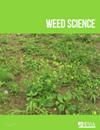一年生制蓝草抗甲磺隆+碘磺隆-甲基和焦氧磺胺的特性研究
IF 2.5
2区 农林科学
Q2 AGRONOMY
引用次数: 0
摘要
摘要一年生蓝草(Poa annua L.)抗除草剂问题已成为非耕地地区普遍存在的问题。在可耕地,黄花蒿在杂草防治规划中的优先地位往往较低,因为可采取的防治办法多种多样,而且对作物产量的影响相对较小。在爱尔兰,羽化后除草剂主要不是用于控制黄花蓟马,但一些除草剂,包括乙酰乳酸合成酶(ALS)抑制剂甲磺隆-甲基+碘磺隆-甲基,具有黄花蓟马的活性。在这项研究中,从爱尔兰都柏林郡的一块麦田中取样了一个可疑的黄花假蝇种群(POAAN-R),该种群以0.75的田间推荐率存活了中硫隆-甲基+碘硫隆-甲基。单剂量试验证实,疑似POAAN-R已进化出对中硫隆-甲基+碘硫隆-甲基的耐药性,此外,还对pyroxsulam(未在爱尔兰登记用于控制P. annua)产生耐药性,但对氯噻虫胺、草甘膦、对二甲醚和氟芬塞敏感。剂量效应实验表明,POAAN-R对中硫隆-甲基+碘硫隆-甲基的抗性(GR 50抗性指数)均高于敏感POAAN-S(47.8倍)和pyroxsulam(38.0倍),这与ALS蛋白色氨酸(Trp)-574突变有关。马拉硫磷(一种细胞色素P450抑制剂)预处理不能逆转POAAN-R对中磺隆-甲基+碘磺隆-甲基或pyroxsulam的耐药性。ACCase蛋白异亮氨酸(Ile)-1781的自然固有突变对POAAN-R和POAAN-S对clethodim的敏感性没有影响。POAAN-R对草甘膦的敏感性也与EPSPS蛋白的未知突变相对应。根据田间历史,早期杂草控制不佳,加上大量使用中磺隆-甲基+碘磺隆-甲基(通常用量降低),无意中选择了抗als抑制剂的POAAN-R。这是首次报道在耕地环境下,黄花苜蓿对als -中磺隆-甲基+碘磺隆-甲基和pyroxsulam的耐药性。有机会使用除草剂有效地控制POAAN-R,但这需要广泛和多样化的方法,加上文化/非化学实践。本文章由计算机程序翻译,如有差异,请以英文原文为准。
Characterization of Mesosulfuron-Methyl + Iodosulfuron-Methyl and Pyroxsulam-Resistant Annual Bluegrass (Poa annua) in an Annual Cropping System
Abstract Herbicide-resistant annual bluegrass ( Poa annua L.) has become a problem in non-arable land areas. In arable fields, P. annua is frequently of lower priority in weed control programmes due to the variety of control options available and the relatively modest impact on crop yield than other species. In Ireland, postemergence herbicides are not primarily intended for P. annua control, but some herbicides, including acetolactate synthase (ALS)-inhibitor mesosulfuron-methyl + iodosulfuron-methyl, exhibit P. annua -activity. In this study, a suspected P. annua population (POAAN-R) that survived mesosulfuron-methyl + iodosulfuron-methyl at 0.75 of field-recommended rate was sampled from a wheat field in County Dublin, Ireland. Single-dose testing confirmed that the suspected POAAN-R had evolved resistance to mesosulfuron-methyl + iodosulfuron-methyl and additionally, to pyroxsulam (not registered in Ireland for P. annua control), but was sensitive to clethodim, glyphosate, pendimethalin and flufenacet. Dose-response experiments indicated that POAAN-R was more resistant (GR 50 resistance index) to both mesosulfuron-methyl + iodosulfuron-methyl (47.8 times) and pyroxsulam (38.0 times) than sensitive POAAN-S and this was associated with the mutation at tryptophan (Trp)-574 in ALS protein. Malathion (a cytochrome P450 inhibitor) pre-treatment did not reverse POAAN-R resistance to mesosulfuron-methyl + iodosulfuron-methyl or pyroxsulam at field rate or above. The natural inherent mutation at isoleucine (Ile)-1781 in ACCase protein had no effect on both POAAN-R and POAAN-S sensitivity to clethodim. The glyphosate sensitivity of POAAN-R also corresponded with no known mutation in EPSPS protein. Based on field histories, poor early-season weed control coupled with intensive use of mesosulfuron-methyl + iodosulfuron-methyl (often at reduced rates) has unintentionally selected for ALS-inhibitor-resistant POAAN-R. This is the first report to characterize resistance in P. annua to ALS-mesosulfuron-methyl + iodosulfuron-methyl and pyroxsulam in an arable setting. There is an opportunity to effectively control POAAN-R using herbicides, but this needs a wide-ranging and varied approach, coupled with cultural/non-chemical practices.
求助全文
通过发布文献求助,成功后即可免费获取论文全文。
去求助
来源期刊

Weed Science
农林科学-农艺学
CiteScore
4.60
自引率
12.00%
发文量
64
审稿时长
12-24 weeks
期刊介绍:
Weed Science publishes original research and scholarship in the form of peer-reviewed articles focused on fundamental research directly related to all aspects of weed science in agricultural systems. Topics for Weed Science include:
- the biology and ecology of weeds in agricultural, forestry, aquatic, turf, recreational, rights-of-way and other settings, genetics of weeds
- herbicide resistance, chemistry, biochemistry, physiology and molecular action of herbicides and plant growth regulators used to manage undesirable vegetation
- ecology of cropping and other agricultural systems as they relate to weed management
- biological and ecological aspects of weed control tools including biological agents, and herbicide resistant crops
- effect of weed management on soil, air and water.
 求助内容:
求助内容: 应助结果提醒方式:
应助结果提醒方式:


